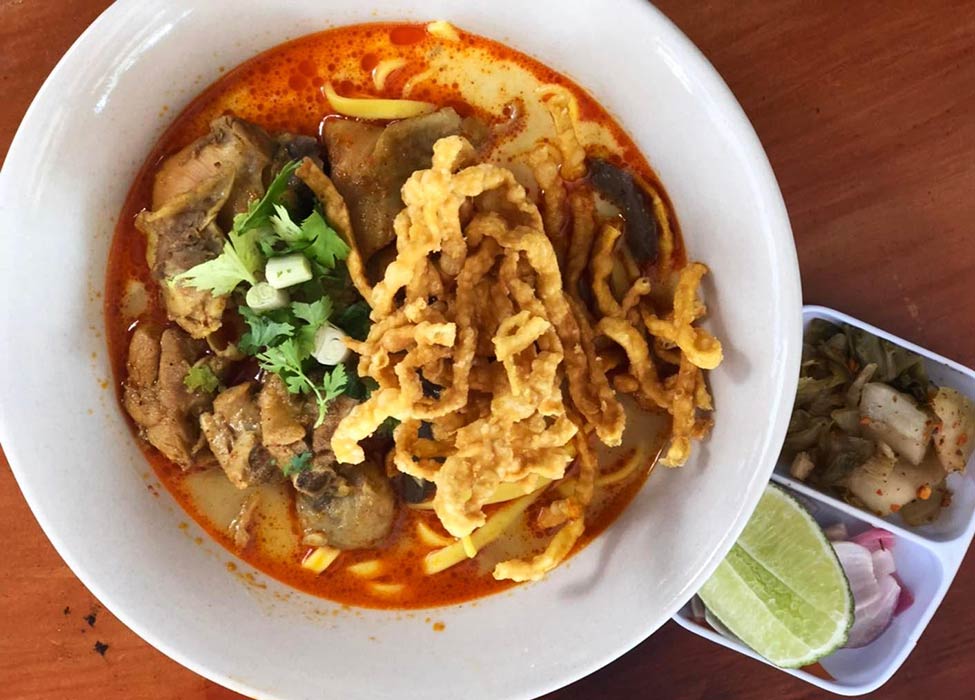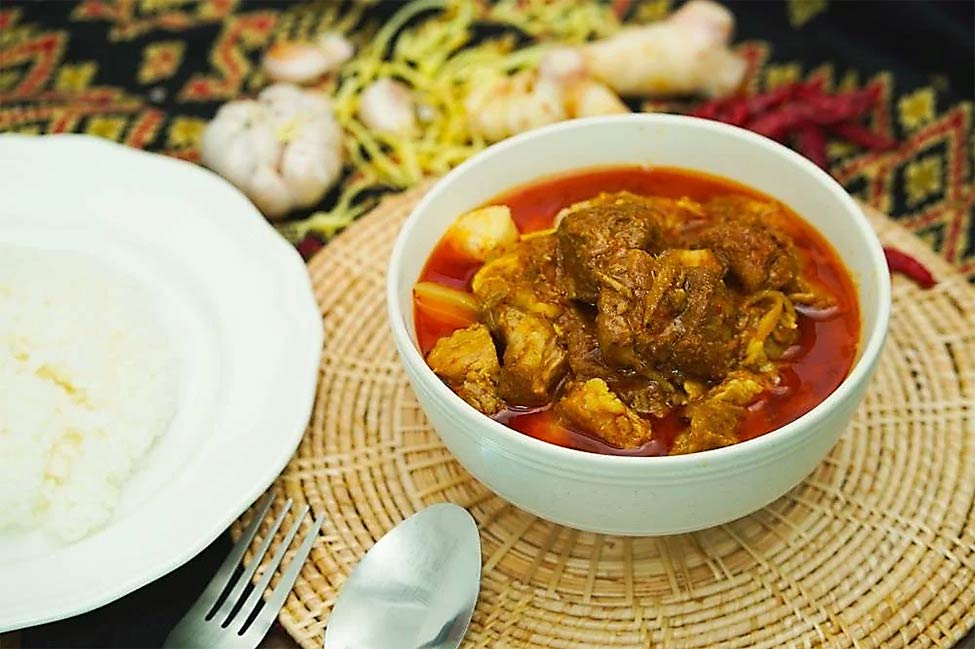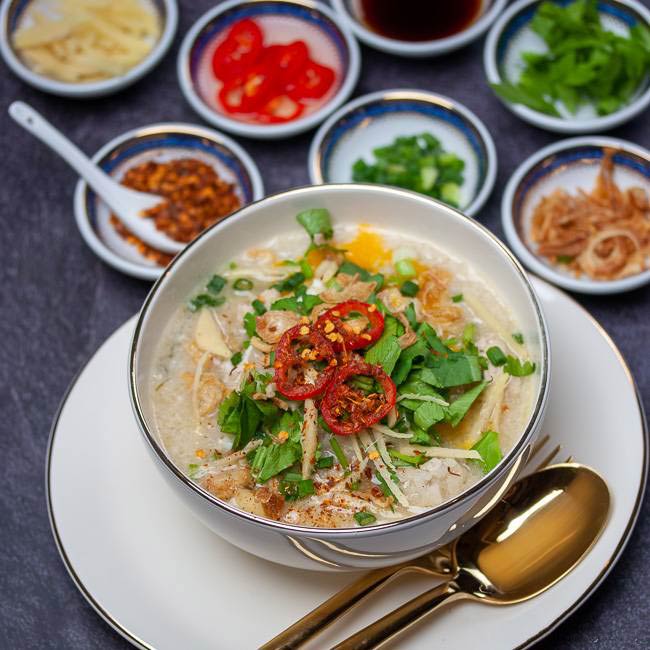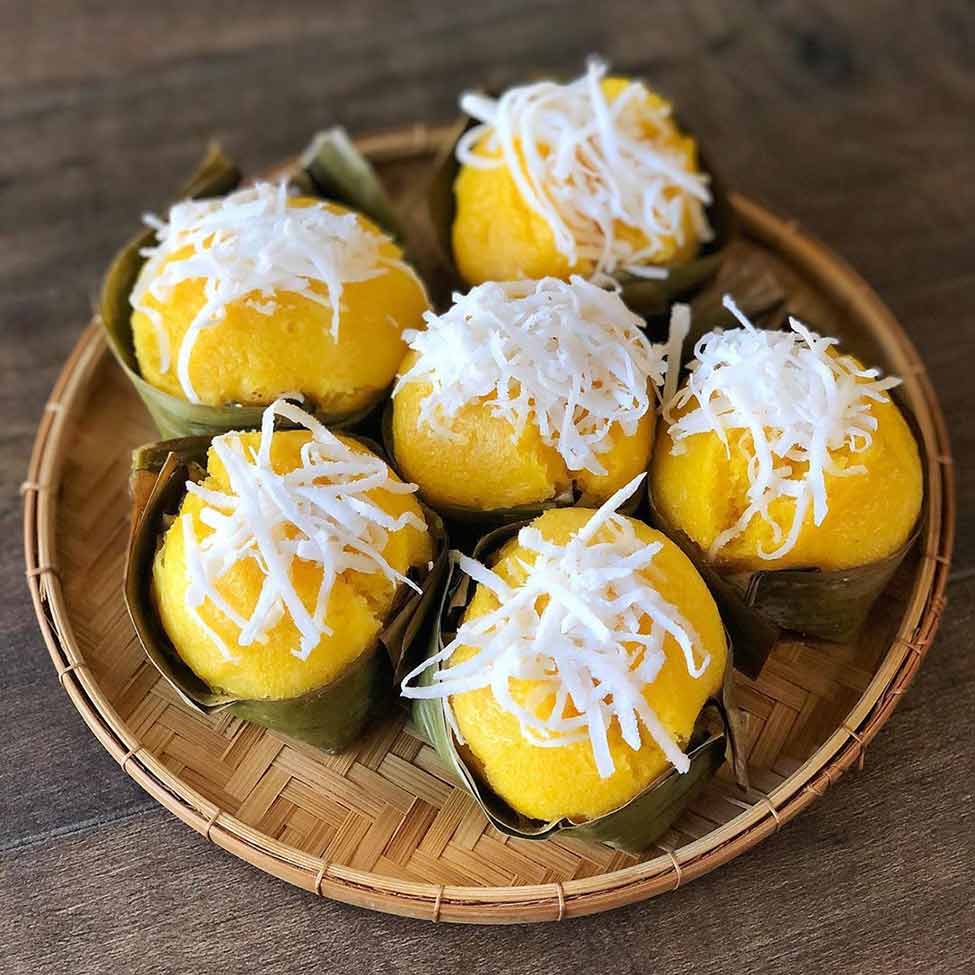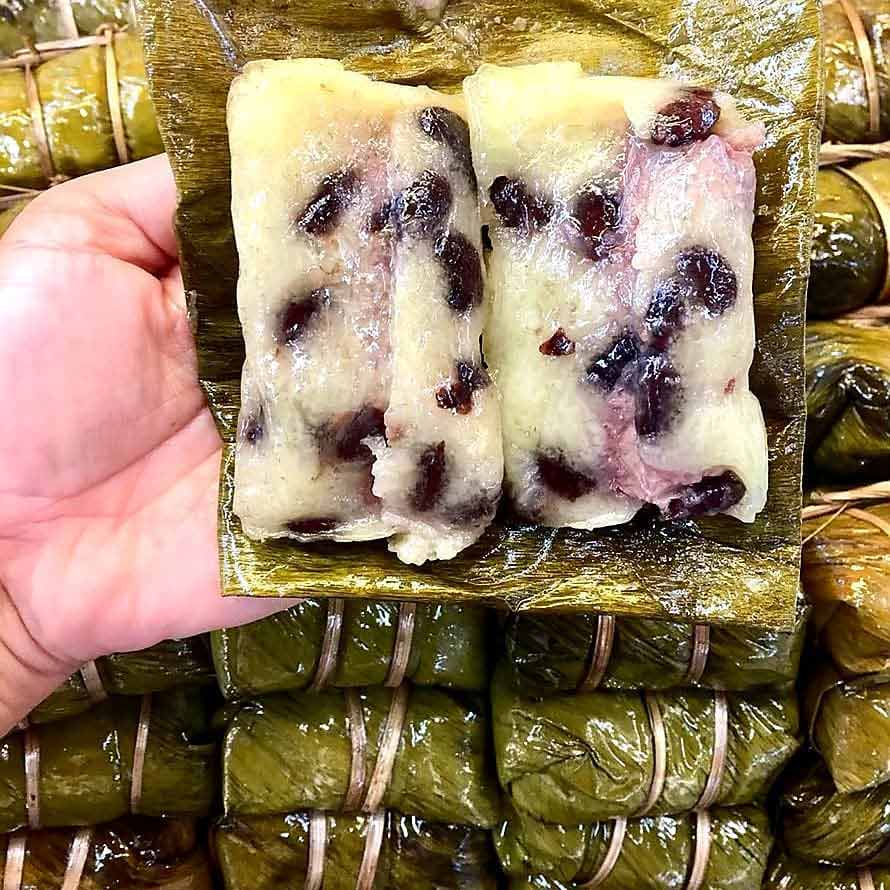Chiang Mai boasts a fusion of Thai, Burmese, and Chinese influences in its local cuisine. From aromatic spices to bold flavours, the food scene in Chiang Mai is a feast for the senses. Some of the best dishes include khao soi, a rich coconut curry soup with crispy noodles, and sai oua, a fragrant pork sausage infused with lemongrass and other herbs. Exploring the city’s street food scene is an adventure in itself, with night markets and food carts lining the streets. As you wander through the city, the tantalising aromas of grilling meats, steaming noodles, and simmering curries fill the air. And don’t forget to wash it all down with a refreshing glass of cha yen, the beloved Thai iced tea. Chiang Mai’s food scene is a journey into culinary bliss.
Khao Soi
Khao soi is more than just a bowl of noodles and broth. People in northern Thailand have passed down this cultural experience through generations. The dish is a creamy, spicy, and coconutty broth made with tender braised chicken and served over egg noodles. The garnish of crispy fried noodles, pickled mustard greens, lime, and shallots provides the dish with a perfect balance of flavors, elevating it beyond its already delicious base.
Khao soi‘s origin is still up for debate. What’s certain is it’s a staple dish in northern Thailand, with each vendor putting their own twist on the recipe. Some add beef or pork instead of chicken, while others use different spices to suit their customers’ tastes. But no matter the variation, each bowl of khao soi is a work of art. Its creamy texture and bold flavours will leave you wanting more.
When you’re ready to try khao soi, head to the street stalls and food markets throughout Chiang Mai. Hot oil sizzles as the vendors fry up the crispy noodles, and the aroma of the broth wafts through the air. Each vendor has their own style, but what they have in common is the passion they put into their dishes. Take your time and savour each bite, letting the different flavours mingle in your mouth. Crispy fried noodles add a crunch that’s balanced by pickled mustard greens and lime. These provide a burst of sourness that complements the spiciness of the broth.
Khao soi is a necessity for anyone looking for a new culinary adventure in Chiang Mai. And who knows – you might just discover your new favourite Thai dish.
Sai Oua
When you take a bite of sai oua, you’ll notice is the juicy, tender texture of the pork. But it’s the complex and fiery mix of chilli paste, galangal, lemongrass, and kaffir lime leaves that really sets this sausage apart. The spices mingle to create a flavour that lingers long after the meal is finished.
But sai oua is more than just a delicious sausage. It’s a versatile ingredient that can be used in a variety of dishes. For a traditional meal, pair it with sticky rice, fresh herbs, and a spicy chilli dip that takes the heat to the next level. And don’t be afraid to get creative: sai oua can be incorporated into salads, stir-fries, and other dishes to add a burst of flavour.
When exploring northern Thailand, be sure to get sai oua from a local market or street vendor. Take in the sights and sounds of the bustling stalls as you sample this fiery sausage. Sai oua isn’t just a delicious food, but a cultural icon in northern Thailand. It’s a symbol of the region’s unique blend of Thai, Burmese, and Lao influences, and a testament to the ingenuity of local cooks.
Larb Mote Daeng
Looking for a dish that’s sure to pack a punch? Larb mote daeng is a northern Thai delicacy that’s not for the faint of heart. Made with succulent grilled beef, spicy chilli paste, tangy lime juice, and savoury fish sauce, this dish is a flavourful explosion in every bite.
One of the most unique aspects of this dish is the use of army ant eggs as a topping. These small red ant eggs add a distinctive flavour and texture, making it truly one-of-a-kind.
But it’s not just the ingredients that make this dish stand out. Larb mote daeng is a staple in northern Thai cuisine and has a deep cultural significance. It’s often served at festivals and celebrations and is a beloved dish among locals.
When you take a bite of larb mote daeng, the bold flavours of the beef and chilli paste will immediately hit you. The tangy lime juice and savoury fish sauce balance out the spiciness, while the crispy fried rice adds a satisfying crunch.
Overall, larb mote daeng is excellent for anyone looking to experience the unique flavours of northern Thai cuisine. So grab some sticky rice and prepare your taste buds for an adventure!
Kaeng Hang Le
Northern Thailand’s cuisine is a tapestry of flavours and influences, with neighbouring countries such as Laos and Myanmar having a significant impact. One dish that epitomises the region’s culinary excellence is kaeng hang le. This slow-cooked pork belly curry is both hearty and bursting with flavour.
They prepare this dish by simmering tender pork belly cuts in a fragrant blend of spices, including ginger, garlic, and chilli paste. As the pork slowly cooks, the spices infuse the meat, resulting in a fork-tender texture that melts in your mouth. The aroma that fills the kitchen as the curry simmers on the stove is intoxicating, with hints of ginger, garlic, and spices intermingling to create a tantalising scent.
The colours of the dish are equally striking, with the deep-red hue of the curry contrasting beautifully with the fresh green herbs and aromatic spices. The addition of fresh herbs such as Thai basil or cilantro adds a burst of freshness that complements the rich, earthy flavours of the curry.
In northern Thailand, locals have their own unique variations of kaeng hang le. For instance, some regions prefer to use different types of chillies or add extra ingredients such as tamarind or palm sugar to create a more nuanced flavour profile. These variations are a testament to the region’s culinary traditions and the creativity of the local people.
Beyond its delicious taste, kaeng hang le also has cultural significance. It’s has been passed down through generations of northern Thai families, with each family adding their own unique twist to the recipe. It’s often served during special occasions, such as weddings or festivals, and is an essential part of northern Thailand’s food culture.
Nam Prik Noom
Nam prik noom is a popular dish in Chiang Mai well worth trying. Made from roasted green chillies, garlic, and shallots, it’s a flavourful and spicy dip that’s perfect for adventurous eaters.
To really appreciate nam prik noom, it’s important to understand the combination of flavours at play. The roasted green chillies taste slightly sweet and smoky, while the garlic and shallots add depth and complexity. When mixed together, these ingredients create a truly delicious and spicy dip that’s perfect for pairing with a variety of foods.
One of the best things about nam prik noom is how easy it is to enjoy. Simply scoop it up with some grilled meat or steamed vegetables, and you’re good to go. It’s the perfect way to add spice to your meal and experience the bold flavours of northern Thai cuisine.
While it’s widely available at markets and street vendors throughout Chiang Mai, you may want to seek out vendors who roast their chillies over an open flame for an extra smoky flavour. And don’t be afraid to experiment with different food pairings. Nam prik noom is versatile enough to be enjoyed with all sorts of dishes, from sticky rice to crispy pork rinds.
If you’re looking to experience the unique flavours and culinary traditions of northern Thailand, nam prik noom is a great place to start.
Kanom Jeen Nam Ngiaw
When it comes to noodle dishes in northern Thailand, kanom jeen nam ngiaw is the go-to for a comforting meal. The fermented rice noodles, known as kanom jeen, are the star of the show, lending their soft and chewy texture to the spicy pork broth. But what really sets this dish apart is the tender braised pork. They slow-cook the pork until it becomes fall-apart tender, then shred it and sprinkle it on top of the noodles to add a savoury note.
But it’s not just the pork that’s noteworthy. The pickled greens and fresh herbs provide a tangy flavour that cuts through the richness of the broth. To make the broth, they simmer pork bones for hours until they release their flavour. Then, they season the broth with chilli paste, garlic, and ginger to give it a fiery kick.
When you’re exploring northern Thailand, you’ll find kanom jeen nam ngiaw on the menus of street food stalls and restaurants. But if you’re hunting for an exceptional experience, make your way to the small town of Ban Rong Ha, where you’ll find a small family-owned restaurant that has been serving up the dish for generations. The restaurant may be unassuming, but the flavour of their kanom jeen is out of this world.
Kao Tom
The fragrant aroma of ginger and coconut milk fills the air as you take your first spoonful of kao tom. This classic northern Thai dish that has stood the test of time. This sweet and savoury sticky rice soup is a comforting and versatile meal, perfect for any time of day.
They make the rich, creamy broth with coconut milk, adding a touch of sweetness that complements the savoury meat perfectly. The addition of ginger gives the soup a slight kick that balances the sweetness and adds depth to the flavour. Whether made with chicken or pork, kao tom is a warming and satisfying meal.
Kao tom has a long history in northern Thai cuisine. People enjoy it as a staple dish during the cooler months. Families and friends often share the dish, symbolising the importance of community and togetherness in Thai culture.
If you’re looking to explore the flavours of northern Thailand, kao tom encapsulates the region’s culinary heritage. Taste this beloved classic for yourself and discover the warmth and comfort of northern Thai cuisine.
Khanom Tan
Are you a fan of sweet treats? If so, you have to try khanom tan, a delectable dessert from northern Thailand. Made with glutinous rice flour, this sweet and chewy confection has a texture similar to mochi, making it a unique and satisfying dessert.
They shape the dough into small balls to make khanom tan. Then they fill the dough with a sweetened bean paste made with mung beans or red beans, sugar, and coconut milk to create a creamy and sweet filling. They create the dough by combining glutinous rice flour with water. Then they steam it until it becomes soft and pliable. Once they roll the filling into the dough, they steam the dessert until it is cooked through.
When you taste khanom tan, you’ll understand why it’s such a popular dessert. It’s often served warm, with a generous pouring of coconut cream and palm sugar syrup. This balances the chewy texture of the dough with a creamy sweetness.
Khanom tan is not just a dessert, it’s a cultural icon of northern Thai cuisine. It’s easy to find in street stalls and traditional markets throughout the region. And its affordable price makes it a popular mid-afternoon snack or dessert after a spicy meal.
The history of khanom tan is not entirely clear. Some believe the Tai Yuan people, who migrated to northern Thailand from China, introduced it. It’s said that the dessert was served during special occasions, such as weddings, and became popular among locals over time.
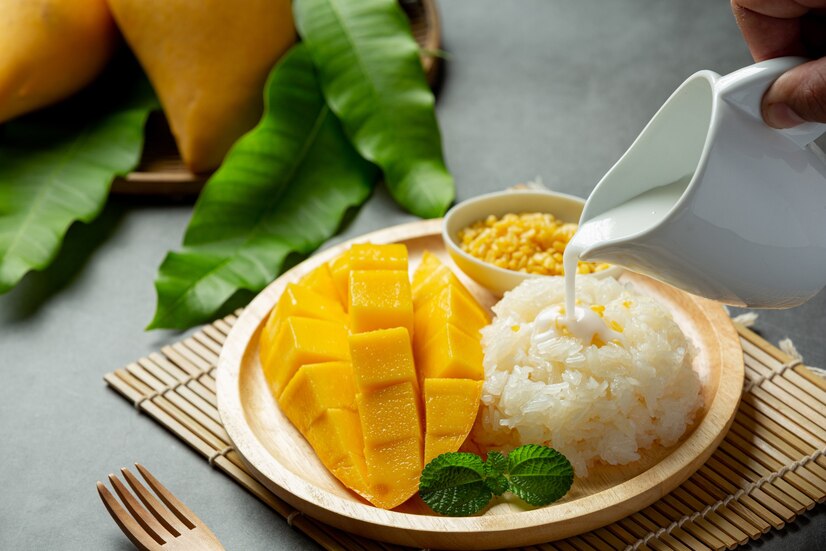
Mango Sticky Rice
Indulge your senses in the flavours and textures of Thailand with the heavenly mango sticky rice. This classic dessert is a beloved staple in Thai cuisine. Its harmonious blend of sweet, sticky glutinous rice and luscious, juicy mango slices that burst with flavour. The coconut milk and sugar the rice is cooked in infuses it with a subtle creaminess that perfectly complements the mango.
But there’s more to this dish than just its exquisite taste. Mango sticky rice is a cultural icon in Thailand, steeped in tradition and history. It’s often enjoyed as a refreshing dessert during the hot and humid summers. It’s also a popular breakfast dish that invigorates the senses.
What’s more, mango sticky rice is incredibly easy to make at home. So, you can bring a taste of Thailand into your kitchen with ease. But don’t be fooled by its simplicity – this dish packs a punch of authentic Thai flavour.
So go ahead, indulge in this beloved delicacy and discover the magic of Thailand’s desserts.
Kao Tom Mut
Indulge in a dessert that perfectly balances the sweet and savoury flavours of northern Thai cuisine: kao tom mut. This delectable dish combines two classic ingredients, sticky glutinous rice and ripe bananas, cooked in rich coconut milk and palm sugar. With each bite, the sticky rice clings to your tongue while the sweetness of the banana complements the nutty flavour of the coconut milk.
Discover the cultural significance of kao tom mut in northern Thai cuisine and explore the many markets and street vendors where you can find it. Take a journey through the streets of Chiang Mai, and you’ll find vendors selling this dessert on the sides of the road, at the night markets, or in local shops.
Conclusion
Chiang Mai’s dining scene has endless options to satisfy any palate. From sizzling street food to mom and pop restaurants and upscale dining establishments, you’ll find it all here. But what really sets Chiang Mai apart is its northern Thai cuisine. With its bold and complex flavours, this cuisine will take your taste buds on a journey you won’t soon forget.
Imagine wandering through the night markets, inhaling the mouth-watering scents of grilled meat and spicy curries. Or sitting down at a small restaurant, watching an expert prepare your dish over an open flame. In Chiang Mai, dining is not just about the food, but the whole experience.
And the food itself? Unique ingredients like khanom jeen, fermented rice noodles, and sai oua, a spicy pork sausage, create a flavour profile unlike anything you’ve ever tasted. The sweet, sour, salty, and spicy flavours balance each other perfectly.
Northern Thai cuisine is not just about the food, but the rituals and traditions that surround it. From communal eating to the use of medicinal herbs and spices, dining in Chiang Mai is a cultural experience in itself.
So, whether you’re a seasoned foodie or just looking for a new culinary adventure, Chiang Mai should be at the top of your list. Don’t miss the chance to sample the flavours that make this region truly unforgettable.

